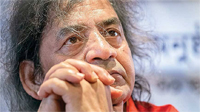 Shahabuddin Ahmed
Shahabuddin Ahmed My friendship with Shahabuddin stretches back over 30 years now, in which, I can confidently proclaim, there has never been a dull moment. Even today, his mere presence manages to bestow an air of bohemia in a room the moment he walks in. Over the years, despite his primary domicile in Paris, it has been more than a pleasure, indeed a delight, to watch him grow into arguably the most important Bangladeshi painter of his generation. Recently he has been conferred with the "Chevalier De L'ordre Des Arts Et Des Lettres" (Knight in the Order of Fine Arts and Humanities) - France's highest civilian title, by the French Ministry for Cultural Affairs. As many will be able to testify, throughout this journey, he has always remained approachable, and humble to a fault.
There is a certain reluctance in the way Shahabuddin wears his celebrity status. It's easy to tell he would much rather discuss an upcoming exhibition in Calcutta, how inadequate he felt beside his fellow students when he first commenced art school in Paris in the mid-Seventies, or the importance of mastering one's technique through the seemingly mundane skill of drawing, than pose for photographs. This is all the more remarkable because almost wherever he may be spotted, it's as if everyone wants a piece of him. I've seen people happy to pose for photographs standing next to him even as he looks away, engrossed in conversation with someone else entirely. It's difficult for people to tear themselves away from Shahabuddin, once they get close to him. He has that magnetic quality to him.
While most painters from Bangladesh, in their quest for achieving the modern ethic, gradually moved further and further away from the figurative to the abstract in their work, Shahabuddin stood out for bucking the trend, and in doing so, forging his own distinctive style that blends both figurative and abstract elements. He is happy to accept the Expressionist tag for his work, and I have often wondered about his uncanny ability to convey rhythm through his paintings. A rhythm that beats to the drum of freedom, reaching out of the canvas and compelling you to listen. How does he convey sound through a silent medium?
As Shahabuddin is fond of saying, there are two types of artists. One likes to pretend that he or she knows exactly how to go about things, and does art in a very learned way. "The other," he once said to me, pointing to his heart, "it's all in there." That presumably, would be the inspired artist, whose oneness with his or her craft doesn't allow the detachment to let them speak in very erudite terms about their work.
For an artist who has dazzled aficionados in some of Europe's most esteemed seats of culture, throughout our association I have always found Shahabuddin's uncompromising emphasis on discipline to be strangely endearing. Here, clearly, is someone whose respect for his craft never wavers. He once told me how he "taught" himself to draw out of a sense of humiliation when he went to Paris; even his juniors were streets better than him apparently. Stung, he locked himself in his room for a year and drew his own naked form, over and over again, till he gained confidence in his ability.
Shahabuddin has always been famed for his participation in Bangladesh's Liberation War in 1971, where he was a platoon commander. The theatre of war must have offered enough of its own share of disturbances, but clearly inspiration as well, as one can easily make out from his oeuvre. From his series on the man who led Bangladesh to independence, Bangabandhu Sheikh Mujibur Rahman, to his arresting depictions of Mukti Bahini fighters in the heat of battle, these on their own constitute one of the most important visual documentations of the Liberation struggle, by an artist on the frontline. His endearing response to the French knighthood ("I, along with my family, carry Bangladeshi passports. I hope the award will enhance the image of my country and inspire Bangladeshi people living across the world.") reflected that despite the years abroad, he feels very much part of the struggle still. Unmistakably, his art is influenced as much by his experiences during the war as by his influences, who range from Francis Bacon, through Jackson Pollack, to Rabindranath and Satyajit Ray.
The boy who was born on the banks of the Meghna, as he often reminds us, sees himself today as part of a family formed by these influences. Inevitably, as the most sought-after Bangladeshi artist on the international stage, Shahabuddin's thoughts on the local art scene are much sought-after. In conversation over the years we have tended to converge on the view that economics has come to play a somewhat disproportionate role in the development of artists. In other words, art's commercial value has tended to trump its inherent and transcendent qualities, whereby a piece of art can open the door to a higher meaning, or consciousness - one that can often get lost in the starkness of reality.
The writer is Editor-in-Chief, United News of Bangladesh and Dhaka Courier.
© 2025 - All Rights with The Financial Express
